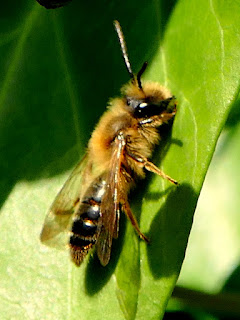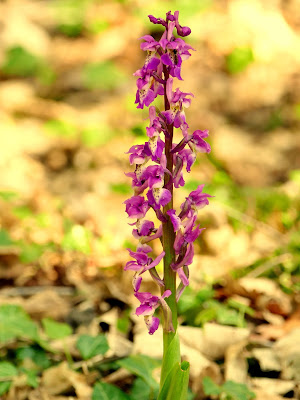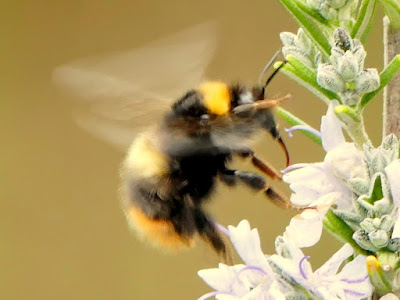The path above, in West Sussex, England was boring before wild garlic seeds were added. Ransoms or wild garlic, Allium ursinum has lovely white flowers at this time of year.
Add a few raw flower florets to a bowl of vegetable soup and the explosion of taste is spectacular -- if you like garlic.
The leaves are attractive yet beware -- the plant is invasive. To check its spread, I run a rotary lawn mower over the flowers before final seed set and compost the leaves in a wild part of the garden.
It was chilly yesterday, less than 10C and Osmia bicornis a Red Mason bee was feeding on the flowers.
Red Mason bees fly March to July and are economically important as a pollinator of fruit trees and oil-seed rape.
The extraordinary lives of wild bees and the important role of gardeners in their survival.
is one of my illustrated talks. Please see http://www.peterlovetttalks.co.uk/page15.html for details.
For illustrated talks on natural history and history see www.peterlovetttalks.co.uk
For illustrated talks on natural history and history click here for www.peterlovetttalks.co.uk
Wednesday, 26 April 2017
Wednesday, 19 April 2017
Large Red Damselfly, Pyrrhosoma nymphula spotted for the first time this year yesterday.
A Large Red Damselfly male, Pyrrhosoma nymphula was spotted for the first time this year yesterday in my garden in Cuckfield, West Sussex, UK. Also in the photo' above is a Nomad, parasitic solitary bee both on honeysuckle leaves. There are dozens of such bees flying around now.
 |
| A Large Red Damselfly male, Pyrrhosoma nymphula on a yew tree. |
Monday, 17 April 2017
Bumblebees, solitary bees and honeybees today in Cuckfield, West Sussex
 |
| Hairy-footed flower bee female on a kale flower |
 |
| Garden bumblebee, Bombus hortorum |
 |
| Garden bumblebee, Bombus hortorum |
 |
| Buff-tailed bumblebee worker, Bombus terrestris |
 |
| Buff-tailed bumblebee worker, Bombus terrestris |
 |
| Common carder bee |
 |
| Common carder bee |
 |
| solitary bee |
 |
| Parasitic Nomad bee |
 |
| Honeybee worker on apple blossom. |
Click on any picture to expand it.
Saturday, 15 April 2017
Bilberry flowers and a Heath bumblebee, Bombus jonellus this afternoon at Old Lodge Nature Reserve, East Sussex, UK
Bilberry flowers are very pretty at this time of the year.
They were being enjoyed by a Heath bumblebee worker, which had collected a good load of pollen.
At least it looks like a Heath Bumblebee, Bombus jonellus and because of the time of year and location -- a high dry(ish) heath, it probably is! These photo's are not quite good enough to be definitive. Click on any picture to expand it,
They were being enjoyed by a Heath bumblebee worker, which had collected a good load of pollen.
At least it looks like a Heath Bumblebee, Bombus jonellus and because of the time of year and location -- a high dry(ish) heath, it probably is! These photo's are not quite good enough to be definitive. Click on any picture to expand it,
Tree Pipet at Old Lodge Nature Reserve today
A Tree Pipet was flying up into the pine above, singing and drifting down with a fanned tail.
Their numbers have declined dramatically in recent years and it was good to see this fine looking bird this afternoon.
Thursday, 13 April 2017
Solitary Adrena spp. bees and their kleptoparasitic Nomad bees flying in big numbers now in Sussex.
Dozens of tiny bees were flying around ivy near Crowlink on the Seven Sisters and the sunny side of a yew hedge in my garden in Cuckfield this week in Sussex.
 |
| Andrena sp. |
 |
| Andrena haemorrhoa, Orange-tailed mining bee. |
 |
| Gooden's Nomad Bee, Nomada goodeniana |
The miniature struggle for survival on our hedgerows is fascinating. You need a good eye: or a good camera to see it. These pictures were taken with a Panasonic ZX1000 camera.
Click on any picture to expand it.
Saturday, 8 April 2017
Early-purple Orchids blooming two weeks earlier than usual in Sussex
Early-purple Orchids are in full bloom now in this Sussex wood -- two weeks earlier than in previous years. Keep your eyes open for these upright purple flowers (in the centre of the picture above).
These following pictures were taken from the same spot using the powerful zoom lens of the Panasonic DMC-FZ1000 camera.
Also emerging from the ground is the Common Twayblade orchid with its characteristic two leaves.
Sussex is a great county for native orchids, which will reach a peak of splendour in June.
To see an orchid spectacle in June, The National Trust is organising an illustrated talk (covering twenty six native orchid species) at the National Trust learning centre at Saddlescombe Farm. The talk will be followed by a walk on Newtimber Hill lead by National Trust Ranger, Graham Wellfare.
The date is Tuesday 20 June 2017 from 10.30 to 13.30hr. and costs £10.00.
Please wear suitable clothing and footwear. Bring a picnic lunch if needed or there is a café onsite. The National Trust will provide tea & coffee.
Booking is essential and places are limited. Call Graham on 01273 857981 or email graham.wellfare@nationaltrust.org.uk to book.
Further details can be found at https://www.nationaltrust.org.uk/events/b2db466a-fdc4-48e8-979f-2fc3df32bdd7/pages/details and please note booking is essential.
Details of the illustrated talk can be viewed at http://www.peterlovetttalks.co.uk/orchids.html
These following pictures were taken from the same spot using the powerful zoom lens of the Panasonic DMC-FZ1000 camera.
Also emerging from the ground is the Common Twayblade orchid with its characteristic two leaves.
Sussex is a great county for native orchids, which will reach a peak of splendour in June.
To see an orchid spectacle in June, The National Trust is organising an illustrated talk (covering twenty six native orchid species) at the National Trust learning centre at Saddlescombe Farm. The talk will be followed by a walk on Newtimber Hill lead by National Trust Ranger, Graham Wellfare.
The date is Tuesday 20 June 2017 from 10.30 to 13.30hr. and costs £10.00.
Please wear suitable clothing and footwear. Bring a picnic lunch if needed or there is a café onsite. The National Trust will provide tea & coffee.
Booking is essential and places are limited. Call Graham on 01273 857981 or email graham.wellfare@nationaltrust.org.uk to book.
Further details can be found at https://www.nationaltrust.org.uk/events/b2db466a-fdc4-48e8-979f-2fc3df32bdd7/pages/details and please note booking is essential.
Details of the illustrated talk can be viewed at http://www.peterlovetttalks.co.uk/orchids.html
Wednesday, 5 April 2017
Hairy-footed flower bees today in Cuckfield, West Sussex, UK
Black-bodied female Hairy-footed flower bees Anthophora plumipes are flying now (here on Rosemary flowers) with conspicuous orange haired legs. Click on the pictures to expand them.
The males fly quickly to and fro and when they settle show their really hairy legs.
The males fly quickly to and fro and when they settle show their really hairy legs.
Tuesday, 4 April 2017
Bees in West Sussex today: Common Carder bee, Early Bumblebee, Hairy-footed flower bees and Honey bees.
Spring is here and how joyous to see more bumblebees. Above looks like a Common Carder bee.
and enjoying nectar from rosemary flowers.
This bee looks like an Early Bumblebee.
And below a much smaller female Hairy-footed flower bee.
Then below honey bees loaded with pollen from Amelanchia canadensis...
and enjoying nectar from rosemary flowers.
Subscribe to:
Comments (Atom)
Blog Archive
-
▼
2017
(68)
-
▼
April
(11)
- Gardening in shade: brightening a shaded path with...
- Large Red Damselfly, Pyrrhosoma nymphula spotted f...
- Bumblebees, solitary bees and honeybees today in C...
- Bilberry flowers and a Heath bumblebee, Bombus jon...
- Tree Pipet at Old Lodge Nature Reserve today
- Solitary Adrena spp. bees and their kleptoparasiti...
- Early-purple Orchids blooming two weeks earlier th...
- Hairy-footed flower bees today in Cuckfield, West ...
- Bees in West Sussex today: Common Carder bee, Earl...
- Egyptian geese in Sussex, 2 April 2017
- Another amazing nature observation from Cuckfield,...
-
▼
April
(11)



































